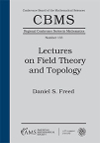- About MAA
- Membership
- MAA Publications
- Periodicals
- Blogs
- MAA Book Series
- MAA Press (an imprint of the AMS)
- MAA Notes
- MAA Reviews
- Mathematical Communication
- Information for Libraries
- Author Resources
- Advertise with MAA
- Meetings
- Competitions
- Programs
- Communities
- MAA Sections
- SIGMAA
- MAA Connect
- Students
- MAA Awards
- Awards Booklets
- Writing Awards
- Teaching Awards
- Service Awards
- Research Awards
- Lecture Awards
- Putnam Competition Individual and Team Winners
- D. E. Shaw Group AMC 8 Awards & Certificates
- Maryam Mirzakhani AMC 10 A Awards & Certificates
- Two Sigma AMC 10 B Awards & Certificates
- Jane Street AMC 12 A Awards & Certificates
- Akamai AMC 12 B Awards & Certificates
- High School Teachers
- News
You are here
Lectures on Field Theory and Topology

Buy Now:
Publisher:
AMS
Publication Date:
2019
Number of Pages:
186
Format:
Paperback
Series:
CBMS Regional Conference Series in Mathematics
Price:
978-1-4704-5206-3
ISBN:
55.00
Category:
Monograph
[Reviewed by , on ]
Jonathan A. Campbell
02/13/2021
Mathematics and physics have always had a close connection, the needs of one sometimes dictating the direction of the other. Witten’s introduction of topological quantum field theories (TQFTs) in the 1980s led to Atiyah’s axiomatization of TQFTs and from there to a renaissance of physical thinking in geometry and topology. An apotheosis of this particular area is the statement, by Baez-Dolan, and proof, by Hopkins-Lurie, of the Cobordism Hypothesis. This roughly states that any TQFT, which is a complicated manifold invariant, is fully determined by its behavior at a point — a geometric statement of physical locality.
The statement and (lengthy) proof of the cobordism hypothesis require some-what serious abstract machinery, higher category theory being the most daunting for many mathematicians. Thus, from physics, we have somehow ended up in a prolonged exercise in higher category theory. While this theory is itself beautiful and important, it presents a serious impediment to those entering into the subject. If one is not concerned with the full, gory details of the abstract underpinnings of the subject, one could instead view the Cobordism Hypothesis as a hypothesis. Here one returns to a more physical mindset: what are the consequences of our hypothesis? What are special cases of the hypothesis? What computations can be made?
This is where Freed’s beautiful lecture notes enter. The eleven lectures roughly follow the outline above. The first half of the lecture notes cleanly outline the march from physics to manifolds to higher category theory, elegantly motivating the arc. In the second half, Freed specializes to invertible field theories which can be investigated with stable homotopy theory. Stable homotopy theory contains a dazzling array of computational techniques and those can be used to get actual answers to classification questions. The second half of the lecture notes thus contain a wealth of computations and describe recent research of Freed and Hopkins, as well as its relationship to the physics literature.
The subject of field theories is broad and the audience for this book should be similarly broad, albeit with differing levels of comfort for different audiences. To get the most out of these lectures the reader should have some comfort with differential topology, methods of homotopy theory (at least at the level of Hatcher’s Algebraic Topology) and a willingness to think categorically. The fastidious reader will be richly rewarded: these lecture notes are meant to be learned from and there are exercises scattered throughout.
This book is an excellent resource both as an introduction to TQFTs as well as a guide to getting one’s hands dirty with computation. I recommend it highly.
Jonathan Campbell is a Research Staff Member at Center for Communications Research – La Jolla. His research is in homotopy theory and algebraic K-theory.
See the publisher's website.
- Log in to post comments




